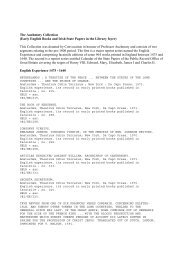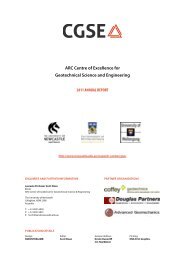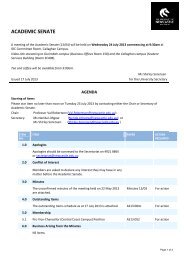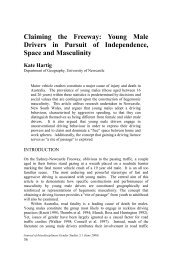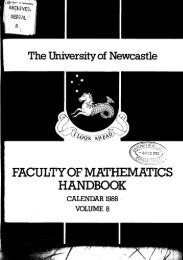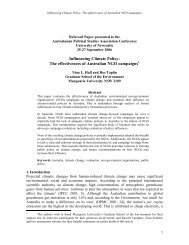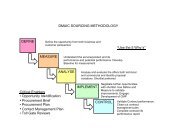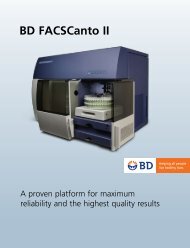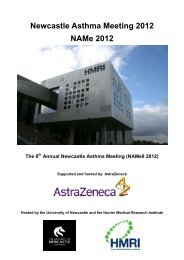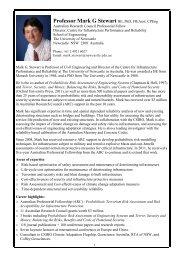Faculty of Mathematic Handbook,1987 - University of Newcastle
Faculty of Mathematic Handbook,1987 - University of Newcastle
Faculty of Mathematic Handbook,1987 - University of Newcastle
Create successful ePaper yourself
Turn your PDF publications into a flip-book with our unique Google optimized e-Paper software.
Text<br />
Lawless, J.<br />
References<br />
Cox, D.R. and Oakes, D.<br />
Elandt-Johnson, R.c.<br />
& Johnson, N .L.<br />
Kalbfleisch. J.D.<br />
& Prentice, R.L.<br />
Keyfitz, N.<br />
Keyfitz, N.<br />
Pollard. J.H.<br />
694104 Statistical Consulting<br />
Prerequisite<br />
. Hours<br />
Examination<br />
Statistical Models & Metlwds for<br />
Lifetime Data (Wiley 1982)<br />
Analysis <strong>of</strong> Survival Data (Chapman & Hall 1984)<br />
Survival Models and Data Analysis<br />
(Wiley 1980)<br />
The Statistical Analysis <strong>of</strong> Failure Time<br />
Data (Wiley 1980)<br />
Applied <strong>Mathematic</strong>al Demography (Wiley 1977)<br />
Introduction to the <strong>Mathematic</strong>s <strong>of</strong> Population<br />
(Addison-Wesley 1968)<br />
<strong>Mathematic</strong>al Models for the Growth <strong>of</strong> Hwnan<br />
Populations (Cambridge Uoi. Press 1975)<br />
Statistics III or equivalent subjects<br />
About 27 hours<br />
Based on assignments and project reports.<br />
Content<br />
The aim <strong>of</strong> this course is to develop the skills necessary for effective statistical<br />
consulting. The course will include discussion <strong>of</strong> papers and other materials about<br />
statistical consulting; consideration <strong>of</strong> aspects such as study design, sample size<br />
estimation and data management; and practical experience <strong>of</strong> consulting projects<br />
including statistical computing and report writing.<br />
94<br />
SUBJECTS OFFERED BY OTHER FACULTIES<br />
This section <strong>of</strong> the handbook contains descriptions <strong>of</strong> subjects taught by departments<br />
outside the <strong>Faculty</strong> <strong>of</strong> <strong>Mathematic</strong>s which are included in the schedules <strong>of</strong> degrees and<br />
diplomas for which the <strong>Faculty</strong> Board <strong>of</strong> <strong>Mathematic</strong>s is responsible.<br />
SUBJECTS IN THE SCHEDULE OF THE B.Comp.Sc. DEGREE<br />
531600 Computer Engineering I<br />
Note: This subject is available only to students enrolled in the Bachelor <strong>of</strong> Computer<br />
Science degree course.<br />
Corequisite<br />
Hours<br />
Examination<br />
Content<br />
<strong>Mathematic</strong>s I<br />
To be advised<br />
To be advised<br />
Computer Engineering I is an introductory course to electrical circuits and digital<br />
systems. The lectures are supported by tutorials and extensive laboratory work. Included<br />
in the laboratory component is an introduction to oscilloscopes, function generators,<br />
electronic power supplies and other laboratory instruments.<br />
Part 1<br />
Introduction to Electrical Engineering. Concepts <strong>of</strong> voltage, current impedance, power<br />
and units <strong>of</strong> same. Voltage sources and current sources. Ohm's Law, Kirch<strong>of</strong>rs Laws.<br />
Parallel and series resistive circuits. Inductors and capacitors and their properties.<br />
Response <strong>of</strong> series RC and LC networks when fed from switched d.c. sources. A.c.<br />
power sources. Peak and r.m.s. quantities. Resistors, capacitors and inductors fed from<br />
sinusoidal voltage sources. Concept <strong>of</strong> phase. The phasor. Complex impedance and<br />
admittance. Phasor diagrams. Power. apparent power and reactive power in a.c. circuits.<br />
Power factor. Balanced 3-phase circuit analysis. Natural and forced response. Simple<br />
LCR circuits.<br />
Part 2<br />
The binary numbering system. Introduction to logic functions and logical circuits.<br />
Combinational logic, analysis and synthesis. MSI and LSI circuits. Elementary sequential<br />
logic. flip-flops, registers, counters and memory devices. Octal and hexadecimal number<br />
systems. Introduction to coding. Basic structures <strong>of</strong> computers. The function <strong>of</strong> the<br />
processor, main and secondary memory, 1/0 devices. Concepts <strong>of</strong> buses. Memory,<br />
processor, 110 device interconnection. Function <strong>of</strong> data, address and control buses.<br />
Introduction to microprocessors. Basic elements <strong>of</strong> the processor, registers. ALU and<br />
control logic. Description <strong>of</strong> machine cycles. Introduction to microprocessor instruction<br />
sets. Example <strong>of</strong> microcomputer interfacing and applications.<br />
95



